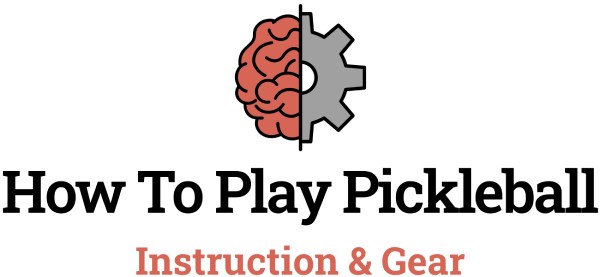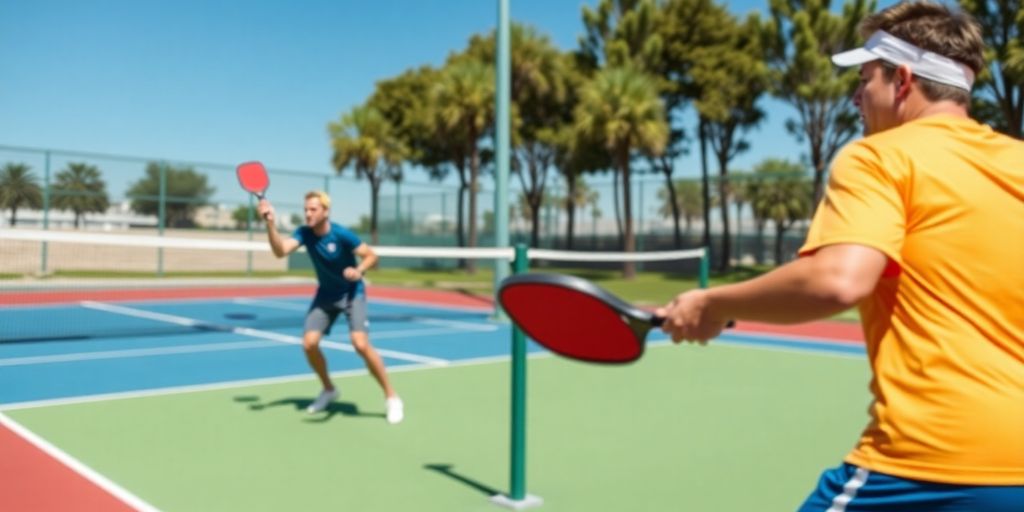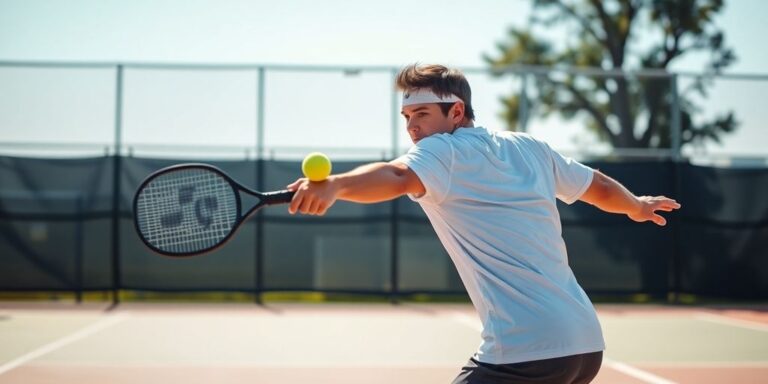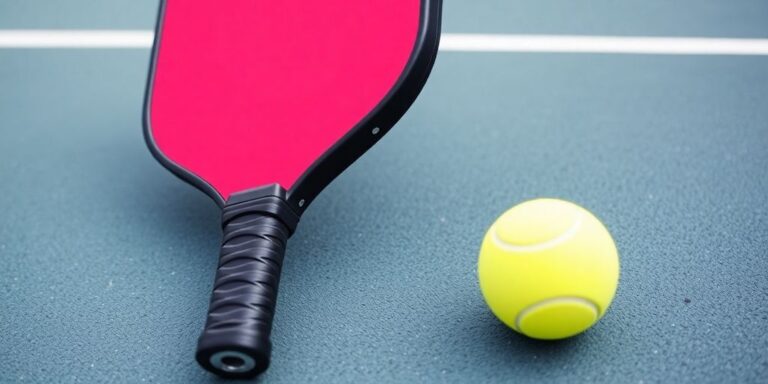Pickleball’s full of exciting moments, but nothing beats the thrill of an Around-the-Post (ATP) shot. It’s not just about hitting the ball; it’s about doing it with style and precision. The ATP shot lets you send the ball around the net instead of over it, catching your opponent off guard. Mastering this shot isn’t just for the pros; with the right technique and practice, anyone can learn it. Let’s dive into the meaning of ATP in pickleball and why it’s a game-changer.
Key Takeaways
- The ATP shot is a legal play where the ball goes around the net post instead of over.
- Proper positioning and footwork are crucial for executing the ATP shot successfully.
- Patience is key; wait for the right moment when the ball is wide enough for an ATP.
- The ATP can turn a defensive play into an offensive advantage.
- Practice specific drills to improve your ATP skills and gain confidence.
The Basics of ATP Pickleball

Understanding the ATP Shot
The Around-the-Post (ATP) shot is one of those moves in pickleball that can really turn heads. Instead of sending the ball over the net, you’re hitting it around the post. It sounds tricky, and it is, but when you pull it off, it’s a real game-changer. This shot happens when your opponent hits a ball so wide that it lands outside the sideline, giving you a clear path around the net post. With no net in the way, you can keep the ball low, making it tough for your opponent to return.
Legal Aspects of the ATP
Is the ATP legal? Absolutely! As long as the ball lands within the court boundaries after going around the net post, it’s a valid shot. The ATP is a legit part of the game, and knowing when and how to use it can be a big plus. It’s all about catching your opponent by surprise and using the court to your advantage.
Why the ATP is a Game-Changer
The ATP isn’t a shot you’ll use in every game, but when you do, it can catch your opponent off guard and give you a significant edge. Executing an ATP successfully can shift the momentum of a rally in your favor. It’s about timing, precision, and a bit of flair. When you master it, not only does it expand your shot repertoire, but it also adds an element of unpredictability to your game.
Mastering the Technique of the ATP Shot
Positioning and Footwork
Getting the positioning and footwork right is the backbone of executing a successful ATP shot. Positioning yourself close to the sideline is key. As soon as you spot a wide shot, hustle towards the sideline. This cuts off the angle and gives you a better chance to send the ball around the post. Your footwork should be quick and nimble, allowing you to reach the ball while maintaining balance. Focus on staying low and balanced as you move, which will help you control the shot when you’re stretched out.
Timing and Patience
The ATP shot is as much about timing as it is about skill. You have to wait for the perfect moment when the ball is low and wide enough. Rushing this shot can lead to errors, like hitting the net or sending the ball out of bounds. Patience is crucial—let the ball travel far enough off the court before making contact. This requires you to read the ball’s trajectory and adjust your timing accordingly.
Paddle Control and Execution
When it comes to paddle control, less is more. You don’t need a powerful swing to make the ATP shot effective. Instead, focus on a controlled, short swing with your paddle face open. The idea is to guide the ball around the post with a smooth motion, not smash it. Using a gentle topspin or underspin can help control the ball’s trajectory, ensuring it lands inside the court. Aim for a spot a few feet inside the sideline to give yourself some margin for error. Control and precision are more important than power here.
Strategic Use of the ATP in Matches

When to Attempt an ATP
The Around-The-Post (ATP) shot is not just for show; it’s a tactical weapon. You should think about using it when you find yourself in a cross-court dink rally, and your opponent hits a wide shot that pushes you off the court. The timing is crucial—let the ball drop low and travel wide enough to give you the right angle. If you’re in a backhand dink rally, avoid trying the ATP if the shots are too close to the center; instead, wait for that wide shot that opens up the court for you.
Reading Your Opponent’s Cues
To make the most of an ATP, you need to read your opponent’s body language and paddle angle. Watch for signs that they’re about to hit a wide shot. This anticipation allows you to position yourself early and prepare for the opportunity. Quick reactions and reading the game are key to pulling off this shot successfully.
Turning Defense into Offense
The ATP is a great way to flip the script. When your opponent forces you wide, they expect you to struggle to return the ball. But with a well-executed ATP, you can turn their offensive play into your own advantage. By sending the ball around the net post, you catch them off guard, often leaving them scrambling to respond. This not only keeps you in the rally but can also put you in a winning position.
Remember, the ATP isn’t just about flash; it’s a smart move when used at the right moment. It can shift the momentum of the game and give you the upper hand.
Common Mistakes and How to Avoid Them
Rushing the Shot
One of the biggest pitfalls when attempting an ATP (Around-the-Post) shot is rushing into it without proper positioning. This often leads to mishits or completely missing the shot. Take your time to set up properly before executing the shot. A few extra seconds to position yourself can make all the difference.
Overhitting the Ball
Many players mistakenly believe that power is key to a successful ATP. In reality, overhitting can send the ball out of bounds or make it easier for your opponent to return. Focus on soft hands and a controlled swing. Keeping your paddle face open and guiding the ball with a smooth motion will help in maintaining control.
Misjudging the Angle
The angle of your shot is crucial in an ATP. Misjudging it can result in hitting the ball into the net or out of play. Pay attention to the ball’s trajectory and adjust your paddle angle accordingly. Practicing angle control can significantly improve your success rate.
Remember, the ATP shot is about precision, not power. It’s more about finesse and control than brute strength.
Tips to Avoid These Mistakes:
- Positioning: Always ensure you’re in the right spot before attempting the ATP. This might mean taking a few extra steps to get there.
- Control Over Power: Instead of trying to smash the ball, focus on gently guiding it around the post.
- Angle Awareness: Regularly practice different angles to get a feel for how the ball reacts to various paddle positions.
By keeping these tips in mind and practicing regularly, you can turn these common mistakes into strengths, enhancing your overall gameplay. For more on improving your pickleball skills, consider engaging with the pickleball community to gain insights and tips from fellow players.
Drills to Improve Your ATP Skills
Wide Shot Recovery Drill
This drill is all about getting comfortable with those wide shots that set up the ATP. Have a buddy hit wide balls to both sides of the court. Your job? Move like lightning to the sideline and get set up for that ATP shot. It’s all about speed and positioning. The quicker you are, the better you’ll get at pulling off this tricky move.
Target Practice for Angle Control
To nail the ATP, you need to master your angles. Set up some targets or cones along the sideline. Practice hitting them with precision. This isn’t just about power; it’s about finesse. Aim to make the ball land just right, so it’s hard for your opponent to return. Consistent practice here will sharpen your accuracy.
Footwork Agility Drill
Footwork is key in pickleball, especially for the ATP. Work on your lateral movements with side shuffles and quick steps. This drill helps simulate the real thing, prepping you to get into position fast when the moment strikes. The more agile you become, the easier it is to execute the ATP with confidence.
Practicing these drills regularly can transform your ATP from a risky shot to a reliable weapon in your pickleball arsenal. Remember, it’s not just about hitting the shot but setting yourself up perfectly to make it happen.
Defending Against the ATP
Anticipating Wide Shots
The first step in defending against an ATP shot is to anticipate wide shots early. If you can prevent your opponent from getting into a position to execute this shot, you’re already ahead of the game. Here’s how you can do it:
- Keep Your Shots Centered: Aim for the middle of the court to reduce the chances of your opponent being able to hit a wide shot.
- Watch Your Opponent’s Paddle: Be alert to their paddle angle and body positioning. This can give you clues about whether they’re setting up for a wide shot.
- React Quickly: If you see a wide shot coming, move swiftly to adjust your position and prepare for a potential ATP attempt.
Positioning Yourself Correctly
When your opponent is setting up for an ATP, your positioning on the court becomes crucial. Correct positioning can turn a seemingly impossible defense into a successful one. Consider these tips:
- Angle Your Body: Position your body towards where the shot will likely come from. This means aligning your feet and shoulders in anticipation of the trajectory.
- Stay Low and Balanced: Maintain a low center of gravity to react quickly. This helps in adjusting your position without losing balance.
- Footwork: Use quick, lateral movements to cover the court effectively, making it harder for your opponent to find an open angle.
Keeping the Rally Alive
The ATP may be flashy, but it’s just one point. Keeping the rally alive can often frustrate your opponent and lead to errors on their part. Here’s how you can maintain the rally:
- Return with Precision: Focus on returning the ball with control rather than power. A precise shot can put your opponent on the defensive.
- Play Smart: Choose shots that keep your opponent moving, wearing them down over time.
- Stay Calm: Even if your opponent successfully hits an ATP, remember it’s just one point. Stay focused on the overall game strategy.
Defending against an ATP can feel daunting, but by focusing on anticipation, positioning, and maintaining the rally, you can turn a potential disadvantage into an opportunity to regain control and keep your opponent on their toes.
The Psychological Edge of the ATP
Intimidating Your Opponent
An ATP shot can be a real game-changer when it comes to messing with your opponent’s head. Imagine pulling off one of these shots, and suddenly, the opponent’s confidence takes a nosedive. It’s like showing them that you can hit shots from impossible angles. This kind of play can make them second-guess every move they make. They might start playing more cautiously, and that’s when you can really take control of the game.
Building Confidence with ATP
Nailing an ATP isn’t just about the point you win; it’s about the confidence boost you get. When you know you can pull off such a tricky shot, it adds a layer of self-assurance to your game. You start to feel like there’s nothing you can’t do on the court. This confidence can spill over into other aspects of your game, making you a more formidable opponent overall.
The ATP as a Momentum Shifter
The ATP shot has this incredible ability to shift the momentum of a match. Let’s say you’re trailing behind, and then you hit an ATP. Suddenly, the energy shifts. Both you and your partner feel that surge of adrenaline, while your opponents might feel the pressure mounting. It’s like a wake-up call that says, "Hey, we’re still in this!" This momentum shift can turn the tide in your favor, making it a crucial tool in high-stakes matches.
The ATP shot is more than just a point scorer; it’s a psychological weapon that can unsettle your opponent and boost your own game. Use it wisely, and it can be the key to turning a match around.
In the world of pickleball, having a mental advantage can make all the difference. Players who understand the psychological aspects of the game often perform better under pressure. If you want to learn more about how to boost your game with mental strategies, visit our website for tips and resources that can help you excel!
Conclusion
So, there you have it. The ATP shot in pickleball isn’t just for the pros—it’s a trick anyone can learn with a bit of practice and patience. Sure, it might take some time to get the hang of it, but once you do, it’s a game-changer. Whether you’re playing for fun or in a competitive match, pulling off an ATP can really shake things up and give you the upper hand. Just remember, it’s all about timing and positioning. So next time you’re on the court, keep an eye out for that perfect moment to go around the post and surprise your opponent. Happy playing!
Frequently Asked Questions
What is the ATP shot in pickleball?
The ATP, or Around the Post shot, is a special move where you hit the ball around the net post instead of over it. This can surprise your opponent and make it hard for them to return the ball.
Is the ATP shot legal in pickleball?
Yes, the ATP shot is completely legal in pickleball. The rules allow you to hit the ball around the net post as long as it lands inbounds on the other side.
When should I try an ATP shot?
You should try an ATP shot when your opponent hits the ball wide, giving you a chance to hit around the post. It’s best attempted when you are pulled to the sideline.
What are common mistakes when trying an ATP shot?
Common mistakes include rushing the shot, using too much power, and not angling the ball correctly. These can cause you to miss the shot or make it easy for your opponent to return.
How can I practice the ATP shot?
You can practice the ATP shot by doing drills that improve your footwork and angle control. Practicing with a partner who can hit wide shots can also help.
How do I defend against an ATP shot?
To defend against an ATP shot, anticipate wide shots early and position yourself correctly to return the ball. Watching your opponent’s movements can also give you clues about their intentions.




